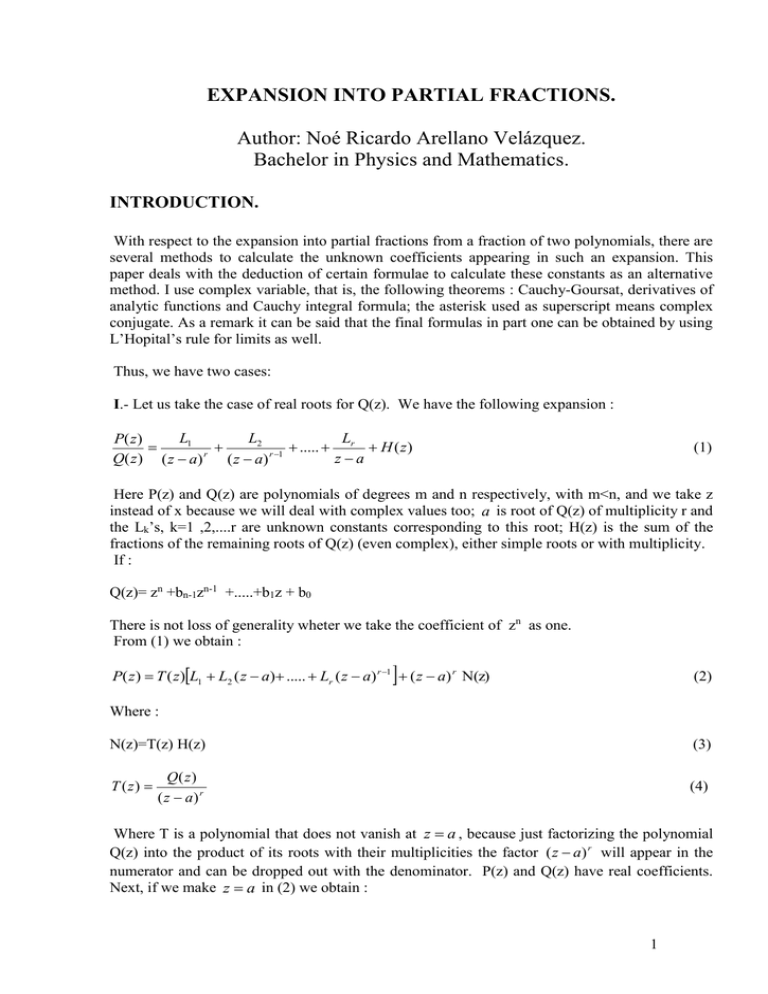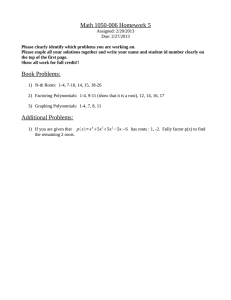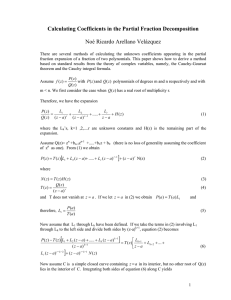EXPANSION INTO PARTIAL FRACTIONS. Author: Noé Ricardo Arellano Velázquez.
advertisement

EXPANSION INTO PARTIAL FRACTIONS.
Author: Noé Ricardo Arellano Velázquez.
Bachelor in Physics and Mathematics.
INTRODUCTION.
With respect to the expansion into partial fractions from a fraction of two polynomials, there are
several methods to calculate the unknown coefficients appearing in such an expansion. This
paper deals with the deduction of certain formulae to calculate these constants as an alternative
method. I use complex variable, that is, the following theorems : Cauchy-Goursat, derivatives of
analytic functions and Cauchy integral formula; the asterisk used as superscript means complex
conjugate. As a remark it can be said that the final formulas in part one can be obtained by using
L’Hopital’s rule for limits as well.
Thus, we have two cases:
I.- Let us take the case of real roots for Q(z). We have the following expansion :
L1
L2
L
P( z )
..... r H ( z )
r
r 1
Q( z ) ( z a )
za
( z a)
(1)
Here P(z) and Q(z) are polynomials of degrees m and n respectively, with m<n, and we take z
instead of x because we will deal with complex values too; a is root of Q(z) of multiplicity r and
the Lk’s, k=1 ,2,....r are unknown constants corresponding to this root; H(z) is the sum of the
fractions of the remaining roots of Q(z) (even complex), either simple roots or with multiplicity.
If :
Q(z)= zn +bn-1zn-1 +.....+b1z + b0
There is not loss of generality wheter we take the coefficient of zn as one.
From (1) we obtain :
P( z ) T ( z )L1 L2 ( z a) ..... Lr ( z a) r 1 ( z a) r N(z)
(2)
Where :
N(z)=T(z) H(z)
(3)
Q( z )
( z a) r
(4)
T ( z)
Where T is a polynomial that does not vanish at z a , because just factorizing the polynomial
Q(z) into the product of its roots with their multiplicities the factor ( z a) r will appear in the
numerator and can be dropped out with the denominator. P(z) and Q(z) have real coefficients.
Next, if we make z a in (2) we obtain :
1
P(a) T (a) L1
L1
P(a)
T (a)
(5)
In this way we can calculate L1. Now if we pass in (2), L1 through Lk to the left side and divide
both sides by (z-a)k+1, it becomes :
P( z ) T ( z ) L1 L2 ( z a) ..... Lk ( z a) k 1
L
T ( z ) k 1 Lk 2 ...
k 1
( z a)
z a
Lr ( z a)
r k 2
( z a)
r k 1
(6)
N ( z)
If we integrate in the complex plane on a curve C such that a is the only root of Q(z) inside,
then (6) becomes :
P( z ) T ( z ) L1 L2 ( z a ) ..... Lk ( z a ) k 1
T ( z ) Lk 1
dz
k 1
C
za
( z a)
C
T(z) L
k2
... Lr ( z a )
r k 2
( z a)
r k 1
(7)
N ( z )dz
C
Here C denotes a simple closed curve which has z a within.
Since the integrands of the second and third integrals on the right side of (7) are analytic
functions on and inside the curve C, these integrals are zero by the Cauchy-Goursat theorem; for
the first integral we use the Cauchy integral formula :
f ( z)
1
f ( z)
dz
2i C z z 0
(8)
For the integral on the left side we can use the theorem on the derivative of analytic functions :
f (n) ( z)
n!
f ( z)
dz
2i C ( z a) n1
(9)
Where C is as right above a simple closed curve that contains z=z0 inside and f(z) is analytic
there.
If we liken equation (7) with (8) and (9) we see that numerators in the fractions of (7) can be
regarded as f(z) of (8) and (9), and a as z0.
Because of these theorems (7) becomes :
P ( k ) (a)
Lk 1
k 1
dk
[
T
(
z
)
Lm1 ( z a) m ] z a
k
dz
m 0
k!T (a)
(10)
Next, using Leinitz’s rule for the derivative of the product of two functions :
2
n
(uv) ( n ) C nh u ( n h ) v ( h )
(11)
h 0
Applied to the term with minus sign of the numerator in (10), it gives :
k h k 1
k 1
k
dk
m
h d
[
T
(
z
)
L
(
z
a
)
]
{
C
[ L ( z a) m ] z a T ( h ) (a)}
m 1
z a
k
k
k h m 1
dz
dz
m 0
h 0
m 0
(12)
After some calculations we obtain :
d k h k 1
[ Lm1 ( z a) m ] z a (k h)! Lk h1
dz k h m0
(13)
Besides :
C kh
k!
h!(k h)!
(14)
Hence,(12) remains as :
k 1
k
dk
k!
m
[
T
(
z
)
L
(
z
a
)
Lk h1T ( h ) (a)
m
1
k
dz
m 0
h 1 h!
Therefore (10) becomes :
k
Lk 1
k! ( h )
T (a) Lk h1
h 1 h!
k!T (a)
P ( k ) (a)
(15a)
Or developing :
P ( k ) (a) [T ( k ) (a) L1 T ( k 1) (a)kL2 T ( k 2) (a)k (k 1) L3 ... T ' (a)k! Lk ]
Lk 1
k!T (a)
k=1, 2, ..., r-1
(15b)
The superscripts (k) and (h) mean derivatives. (15a) is a recurrence formula namely, doing k=1
we obtain :
P' (a ) T ' (a ) L1
T (a)
But as we can before calculate L1 by means of (5) we can obtain L2. Afterwards, doing k=2 :
L2
L3
P '' (a) [T '' (a) L1 2T ' (a) L2 ]
2T (a)
3
Since we already know L1 and L2 we can calculate L3 and so on, until we have the r
coefficients.
Expansion (1) holds for complex roots too, even for polynomials with complex coefficients;
furthermore formulas (5) and (15a,b)are valid for polynomials with complex coefficients as well,
since all the calculations made to get to these formulas can be applied for such polynomials too.
In the case where P(z) and Q(z) have real coefficients there exist fractions of the forms :
L
( z a) t
and
N
(z a* )t
Where a is a complex root of multiplicity r of Q(z) as well as a * . It also hods that N=L*; this
can be proven.
II.-Case of irreducible quadratic forms.
In what follows we are going to consider quadratic forms in the expansion, i.e., we write the
expression z2 +bz +c which contains the complex roots a and a * .
A z B
A z B1
A2 z B2
P( z )
2 1
...
J ( z)
Q( z ) ( z bz c) ( z 2 bz c) 1
z 2 bz c
(16)
Where the Ak ‘s , Bk ‘s, b and c are real numbers and J(z) is the sum of the fractions
corresponding to the remaining roots of Q(z). Furthermore :
z 2 bz c ( z a)( z a * )
(17)
From (16) we can write :
P( z ) U ( z )[ A1 z B1 ( z a)( z a * )( A2 z B2 ) ( z a) 2 ( z a * ) 2 ( A3 z B3 )
(18)
... ( z a) 1 ( z a * ) 1 ( A z B )] ( z a) G( z )
With :
U ( z)
Q( z )
( z bz c)
(19)
2
G( z ) ( z a * ) U ( z ) J ( z )
(20)
Doing z a in (18). It becomes :
P(a) U (a)( A1 a B1 )
;
A1 a B1
P(a)
U( a)
(21)
The right side is a complex number as well as a ; equating the corresponding real and imaginary
parts we get two equations for A1 and B1 which can be solved and then, obtain their values.
Now if we rearrange (18) as similarly done in part I we get :
4
m 1
P( z ) U ( z ) ( z a ) k ( z a ) k ( Ak 1 z Bk 1 )
k 0
( z a ) m 1
( z a * )( Am 1 z Bm 1 )
U ( z )[
za
(22)
(z - a * )( Am 2 z Bm 2 ) ... (z - a * )( A z B ) -m-2 ] (z - a) -m-1 G ( z )
Now, we take the integral in the complex plane on a closed curve C which contains inside the
only root z a , use the following theorems Cauchy-Goursat, Cauchy integral formula and the nth derivative, (22) becomes :
P
(m)
m 1
dm
(a ) m [U ( z ) ( z a) k ( z a * ) k ( Ak 1 z Bk 1 )] z a
dz
k 0
U (a)( a a * )( Am 1 a Bm 1 )
m!
(23)
Whence :
m 1
Am1 a Bm1
P ( m ) (a) {U (a) ( z a) k ( z a * ) k ( Ak 1 z Bk 1 )}( m ) | z a
k 0
(24)
m!(a a * )U (a)
Let :
F ( z ) U ( z ) ( z a ) k ( z a * ) k ( Ak 1 z Bk 1 )
(25)
Applying Leibnitz’s rule (11) to F(m)(a), and after some long calculations we obtain :
m
F ( m) (a) {C mhU ( mh ) (a)
h 0
m 1
h!
[( z a * ) k (A k 1z B k 1 )](h -k) | z a }
k 0, h (h k )!
(26)
Therefore (24) becomes :
Am1 a Bm1
P ( m ) (a) F ( m ) (a)
m!(a a * ) m U (a)
(27)
m=1, 2, 3, ...., ν-1.
Thus by means of (21) we obtain A1 and B1, after this we make m=1 in (27) and obtain an
expression for A2 and B2 in function of A1 and B1 already known and then we can calculate
them, and so on and so forth, until we obtain all the A’s and B’s.
REFERENCES.
[1] Piskunov, N. Càlculo diferencial e Integral, Vol. 1, 6ª Ed., Editorial Mir.
[2] Uspensky, J. V. Teoría de ecuaciones, 1997, Editorial LIMUSA S.A. DE C.V. .
[3] Churchill, R.V. Complex Variables and Applications, 2nd Ed., International Student Edition.
McGraw Hill Book Company, Inc. .
5



